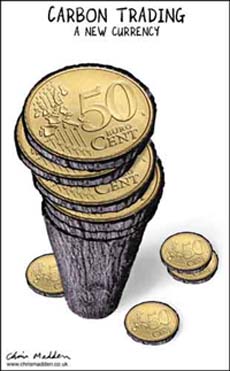The Clean Development Mechanism of
the Kyoto Protocol allows developing countries to profit from climate friendly
projects, and India is second only to China in using the mechanism to help
reduce its carbon emissions.
But,
unlike China, India does not have a national policy.

- As one of the Kyoto Protocol's ‘flexibility mechanisms’, the Clean Development Mechanism (CDM) allows industrialised countries that have, as Kyoto parties, committed to reducing their national carbon emissions to instead support climate mitigation projects in developing countries, such as renovating power plants or installing solar panels.
- Since the cost of carbon abatement is often lower in developing than in industrialised countries, the CDM allows industrialised countries to cost-effectively reduce their greenhouse gas emissions while promoting sustainable development in countries that host CDM project.
- India is one of the world's largest hosts of such clean development projects. From 2003 to 2011, a total of 2,295 projects – around one-quarter of the global total – had been registered with India's Designated National Authority for the Clean Development Mechanism. Only China hosts more such projects than India.
- India's approach to governing the CDM is best characterised as a ‘laissez faire’ system whereby the Indian government neither actively promotes nor discourages CDM project implementation in different states.
- This stands in stark contrast to China's national policy, which steers CDM investment toward the country's policy priorities, such as renewable energy, and economically backward provinces.

The consequences of India's liberal approach to the CDM for sustainable
development remain unclear. The data analysis reveals that in India, CDM
projects are concentrated in states that
are more industrialised, such as Gujarat and Maharashtra. In contrast,
poorer and less industrialised states generally implement fewer CDM
projects.
Analysis shows that the
amount of fixed industrial capital plays an important role in CDM project
activity. The average Indian state has fixed industrial capital worth around 80
billion rupees. If the base of industrial capital increased (by one standard
deviation) to around 850 billion rupees, the state would implement around seven
additional CDM projects every year. Compared to the mean number of annual CDM
projects in our dataset, around 10, this would be a 70% increase.
Implications for clean development in India
- The concentration of CDM projects in the more industrialised states is understandable, given that the industrial sector is particularly amenable to mitigation. However, the lacklustre performance of the CDM in the less industrialised states also means that the Indian government is not fully capitalising on the CDM's potential to contribute to sustainable development.

- In contrast to China, where the central and provincial governments offer institutional support to CDM project developers, India's liberal approach to the CDM prevents the less industrialised states from benefiting from the investment opportunities that the CDM creates.
To improve the CDM's
contribution to sustainable development in India, the Government of India
should consider investing in capacity building in those less developed states that are
implementing few CDM projects relative to their population, such as Bihar and
Uttar Pradesh. For example, the government could establish information
centres that help investors identify profitable opportunities for project
implementation and advise them with legal and regulatory affairs.


